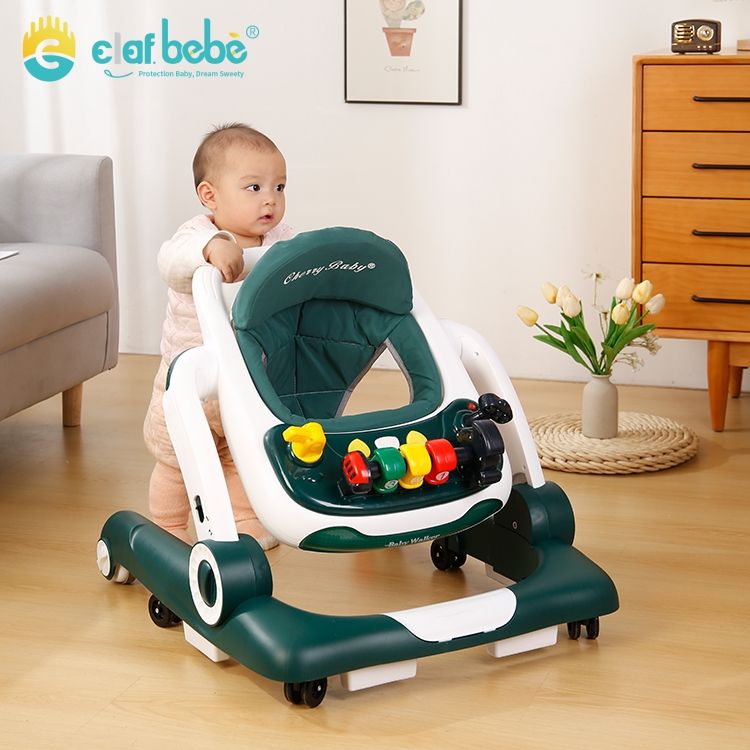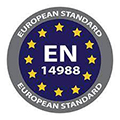Les déambulateurs sont une excellente solution outil de développement pour les bébés car ils les aident équilibre et améliorer leur compétences de coordination motriceBien qu'ils présentent de nombreux avantages pour les bébés, déambulateurs ne sont pas un produit indispensable pour bébé.
Cet article est un guide pour les parents qui envisagent d'acheter un trotteur pour leur bébé. Nous examinerons les risques de sécurité associés au trotteur, comment les utiliser correctement, leur impact sur le développement du bébé et les meilleurs trotteurs pour bébés.
Qu'est-ce qu'un trotteur pour bébé ?
Un trotteur est un produit pour bébé conçu pour aider un bébé à apprendre à marcher. Il est destiné à aider un bébé à se lever du sol ou à passer d'une position assise à une position debout. Par conséquent, un trotteur a une cadre et base robustes qui peut supporter le poids des bébés qui ont atteint le stade de la marche.
Les trotteurs ont une poignée qui doit être facile à saisir pour les bébés. Ils ont également des roues qui permettent aux bébés de les pousser facilement. La plupart des trotteurs ont des roues avec la poignée. fonction de contrôle de vitesseCela limite leur vitesse et réduit les risques d’accidents, protégeant ainsi les bébés.
Certains fabricants de déambulateurs ont ajouté des fonctionnalités telles que la musique, les lumières et les boutons de contrôle de la vitesse pour les rendre plus attrayants pour les clients. Cependant, la sécurité de l'enfant doit être la priorité.
Les déambulateurs sont-ils sûrs ?
Comme pour la plupart des produits pour bébé, sécurité est une préoccupation majeure pour les personnes qui utilisent des déambulateurs. Vous trouverez ci-dessous certaines des caractéristiques de sécurité des déambulateurs.
- Ils sont conçus pour la stabilité et le soutien. Leur cadre est robuste à cet effet. Les trotteurs ont également une base plus large. La base plus large permet aux bébés de maintenir une posture droite lorsqu'ils utilisent le trotteur. Cela les aide également à améliorer leur équilibre. La posture droite et l'équilibre sont importants pour le développement d'un bébé.
- La fonction de contrôle de vitesse permet de réguler la vitesse des déambulateurs. Les trotteurs permettent à l'enfant de réguler son rythme. Des molettes de contrôle de la vitesse et un bouton de contrôle de la vitesse sur le trotteur permettent aux parents de réguler la vitesse du trotteur et d'éviter les accidents.
- La base large et les cadres permettent aux bébés de marcher avec les pieds entièrement sur le sol. Cette conception permet aux bébés d'apprendre à marcher plus rapidement de manière autonome et les aide à éviter des problèmes tels que la marche sur la pointe des pieds lorsqu'ils grandissent. La marche sur la pointe des pieds consiste pour les bébés à marcher sur la pointe des pieds plutôt que sur toute la plante de leurs pieds.
Malgré les mesures de sécurité intégrées au produit, surveillance parentale est nécessaire lors de l'utilisation d'un trotteur. Les parents doivent toujours rester autour du bébé et l'empêcher de heurter des objets ou de s'aventurer dans des zones dangereuses telles que les escaliers.
Un autre conseil de sécurité pour les déambulateurs est qu'ils ne doivent pas être utilisés pour longues périodes. Les experts recommandent que les bébés ne devraient utiliser le trotteur que pendant une maximum 20 minutes par séance. De plus, assurez-vous que votre bébé a démontré un intérêt pour la marche avant d'acheter un trotteur.
Les poussettes sont-elles bonnes pour le développement ?
Les trotteurs aident au développement de la motricité et de la motricité du bébé. compétences mentales.
Les poussettes aident au développement musculaire
Pour utiliser un trotteur, les bébés doivent se soulever du sol en s'aidant de la poignée. S'ils le font régulièrement, leurs muscles commenceront à se développer.
Les poussettes aident les bébés à améliorer leur posture et leur équilibre
Les bébés doivent maintenir une position verticale lorsqu'ils utilisent le trotteur, cela aide à améliorer leur posture et leur équilibre.
Les poussettes permettent aux bébés d'explorer
La mobilité s'accompagne d'une phase d'exploration. Les enfants qui commencent à s'intéresser à la marche sont également en phase de curiosité. Le trotteur leur permet d'accéder à des endroits auxquels ils ne pourraient pas accéder autrement. L'exploration accélère le développement d'un bébé car il découvre et comprend de nouvelles choses.
Les poussettes aident à renforcer la confiance du bébé
Pour les bébés, marcher est comme explorer des terres inconnues. Ils n'ont jamais marché auparavant, ils ne savent pas ce que cela implique et sont donc naturellement effrayés. Les trotteurs aident à renforcer leur confiance en eux en leur permettant de bouger librement tout en les soutenant.
Quand un bébé peut-il utiliser un trotteur ?
En général, les bébés peuvent utiliser un trotteur lorsqu'ils manifestent de l'intérêt pour la marche. Le parcours de marche d'un bébé suit généralement les étapes suivantes : se lever pour se mettre debout, se déplacer, se tenir debout sans aide et enfin marcher.
En règle générale, un bébé peut utiliser un trotteur lorsqu'il peut se lever tout seul pour se mettre debout. Cette étape se produit généralement lorsqu'ils sont sept à dix mois Les capacités motrices des bébés varient d'un bébé à l'autre, mais la tranche d'âge de 7 à 10 ans est l'âge général où les bébés manifestent un intérêt pour la marche et donc l'âge où ils peuvent commencer à utiliser un trotteur.
Il est conseillé de ne pas brusquer votre bébé. Chaque stade de croissance est essentiel au développement du bébé et le fait de l'utiliser trop tôt peut l'empêcher de ramper. Le fait de ramper favorise la coordination du bébé et il ne doit pas l'ignorer.
Comment faire en sorte que votre bébé utilise un trotteur

1. Présentez le trotteur à votre bébé
Achetez le trotteur, apportez-le chez vous et laissez le bébé toucher et se familiariser avec. Une fois qu'ils sont familiarisés avec le déambulateur, la tâche suivante consiste à les faire monter dessus. Cette étape est un peu plus fastidieuse car vous êtes censé leur faire tenir la poignée du déambulateur.
2. Aidez votre bébé à utiliser le trotteur
Le tenir est une chose, le pousser et le tenir est une autre tâche. Placez votre main légèrement sur la sienne et poussez le trotteur. Il sera curieux et un peu effrayé pendant les premières secondes, mais votre présence le rassurera. Vous devrez peut-être faire cela pendant toute la première journée où vous ramènerez le trotteur à la maison. Après l'avoir aidé à tenir le trotteur et à le pousser pour lui plusieurs fois, le bébé voudra le faire tout seul. Néanmoins, vous devez toujours l'inciter à utiliser le trotteur. Les trotteurs avec musique, lumières ou jouets qui tintent aident les bébés à apprendre à marcher plus vite car ils sont attirés par ces caractéristiques.
3. Laissez le bébé utiliser le trotteur tout seul
Vous pouvez donc choisir un trotteur avec ces fonctionnalités supplémentaires pour aider votre bébé à marcher plus vite. Allumez la musique du trotteur ou secouez les jouets pour attirer l'attention de votre bébé et il viendra « en courant ». Une fois qu'il aura pris l'habitude d'utiliser le trotteur, dégager la salle de jeux/la maison des obstacles pour aider votre bébé à se déplacer librement. Il est important de laisser le bébé utiliser le trotteur tout seul après quelques séances d'entraînement. Le fait de pousser le trotteur lui-même l'aide à ajuster son rythme et à apprendre à marcher rapidement.
Activités et jeux à faire avec votre bébé en utilisant un trotteur
Les parents jouent un rôle primordial dans le développement de leurs enfants. Ce rôle ne se manifeste pas lorsque l'enfant grandit et commence à devenir indépendant, il commence dès sa naissance. L'un des domaines du développement de l'enfant dans lequel les parents ou les personnes qui s'occupent de lui jouent un rôle important est la marche. Les enfants ne grandissent pas, ne se réveillent pas un matin et ne commencent pas à trébucher dans la maison.
Voici les raisons pour lesquelles les parents devraient jouer un rôle actif dans le développement de leur bébé :
- Sécurité: À ce stade, les bébés n'ont pas encore développé leur sens du danger et peuvent participer à des activités qui peuvent leur être préjudiciables. Par exemple, s'ils ne sont pas surveillés, ils peuvent essayer de descendre les escaliers et se blesser gravement.
- Le soutien et les encouragements des parents renforcent la confiance de l’enfant : Soutien et encouragement des parents sont liés à la capacité d'apprentissage d'un enfant. Par conséquent, lorsque vous participez à l'apprentissage de la marche du bébé, il y a de fortes chances qu'il apprenne plus rapidement. De plus, les parents peuvent lier avec leurs bébés sous couvert de participer à leur apprentissage.
- Pour suivre leurs progrès et les guider en conséquence : En participant, les parents peuvent noter les progrès de leur bébé dans l’apprentissage de la marche.
Vous trouverez ci-dessous une liste d’activités auxquelles les parents peuvent participer pour aider leur bébé à apprendre à marcher :
1. Créez un « chemin » avec d’autres jouets pour que bébé puisse marcher dessus
2. Lancez une balle pour que le bébé puisse marcher et la trouver
3. Coucou : Cachez des objets de manière répétitive, puis révélez-les plus tard et votre bébé marchera vers vous pour essayer de les trouver.
4. Cache-cache
5. Ramassez des jouets dans la pièce et placez-les dans un récipient et votre bébé les imitera.
Quel est le meilleur trotteur pour bébé
Il existe plusieurs types de déambulateurs, notamment :
- Déambulateurs avec musique : Ce type de trotteur est doté d'un bouton qui permet d'activer la musique ou le son. La musique attire l'attention du bébé sur le trotteur.
- Jouet de marche à pousser : Ce type de trotteur ressemble à un jouet. Son apparence attire l'attention du bébé et l'encourage à s'entraîner à marcher.
- Poussette évolutive pour bébé : Ce trotteur pour bébé peut passer du mode trotteur à pousser au mode trotteur assis-debout. Il permet aux parents d'utiliser l'un ou l'autre des deux modes.
Vous trouverez ci-dessous les meilleurs trotteurs pour votre bébé :
Poussette pour bébé avec musique
Ce trotteur est conçu de manière créative pour ressembler à une voiture de course. Son design suscite l'intérêt, en particulier chez les bébés qui commencent à s'intéresser aux voitures. Ce trotteur peut s'adapter aux étapes de croissance d'un bébé. Il peut être utilisé lorsqu'il commence à s'asseoir et le soutient également lorsqu'il est prêt à faire ses premiers pas.
Ce produit peut être utilisé lorsque les bébés entrent dans la phase de position assise et lorsqu'ils passent de la position assise à la marche. Cela vous aidera à économiser sur les coûts car il s'agit d'un achat unique.
Jouet de marcheur mignon
Ce trotteur aidera à développer la coordination motrice de votre bébé. Il est doté d'une poignée facile à saisir et d'une fonction de contrôle de la vitesse. Sa surface de préhension lisse aide le bébé à améliorer sa force de préhension et de poussée.
De plus, le trotteur est doté d'une conception trois en un qui lui permet de passer d'un trotteur à un tricycle puis à un scooter. Ainsi, en plus d'apprendre à marcher, le bébé peut également l'utiliser comme jouet. Un bouton de contrôle de vitesse aide les roues de contrôle de vitesse à réguler la vitesse du trotteur et à éviter les accidents.
Poussette convertible pour bébé
Ce déambulateur peut basculer en toute transparence entre quatre modes : mode marcheur assis, mode marcheur à pousser, mode rebond et mode rebond avec musique. Cette fonction multifonctionnelle en fait un incontournable pour les parents qui élèvent un tout-petit et un bébé en même temps. Les deux bébés peuvent utiliser le déambulateur et un parent économisera l'argent qui aurait été utilisé pour acheter un autre déambulateur.
La distance entre les protections de ce trotteur améliore non seulement la sécurité en empêchant le bébé de tomber en arrière, mais permet également une répartition équilibrée de la force et empêche le bébé d'avoir les jambes arquées.
FAQ
Vos déambulateurs sont-ils sécuritaires ?
Oui, les trotteurs Clafbebe sont sans danger pour les bébés. Leurs poignées sont conçues pour la prise en main de bébé et leurs cadres et bases sont robustes pour soutenir votre bébé. De plus, les roues de contrôle de vitesse et un bouton de contrôle de vitesse pour réguler la vitesse du trotteur devraient vous rassurer.
Les trotteurs sont-ils plus sûrs que les marchettes pour bébés ?
Oui, les trotteurs à pousser sont plus sûrs que les trotteurs assis-debout. Les trotteurs assis-debout sont plus sujets aux accidents et empêchent les bébés de marcher seuls.
Avez-vous un déambulateur qui peut alterner entre le mode poussée et le mode assise ?
Oui, nous avons des déambulateurs multifonctionnels qui peuvent basculer entre les deux modes et plusieurs autres modes.
Puis-je acheter un déambulateur à poussée simple
Non, la plupart de nos trotteurs pour bébé sont vendus en gros. Le nombre minimum d'unités que vous pouvez commander est de 200
Conclusion
Lorsque vous recherchez un trotteur, plusieurs facteurs importants doivent être pris en compte. Il s'agit notamment de la sécurité, de son impact sur le développement du bébé et de l'âge de votre bébé pour l'utiliser. Cependant, les parents doivent noter que les trotteurs nécessitent une surveillance constante et que les bébés ne doivent pas passer plus de vingt minutes à la fois sur le trotteur.
Clafbebe est un fabricant expérimenté de marchettes pour bébés qui propose une grande variété de styles de marchettes à des prix de gros qui plairont aux distributeurs et aux détaillants. Contactez-nous Pour toute question complémentaire sur les déambulateurs, contactez-nous pour un devis et un catalogue de produits !
Articles connexes recommandés :


